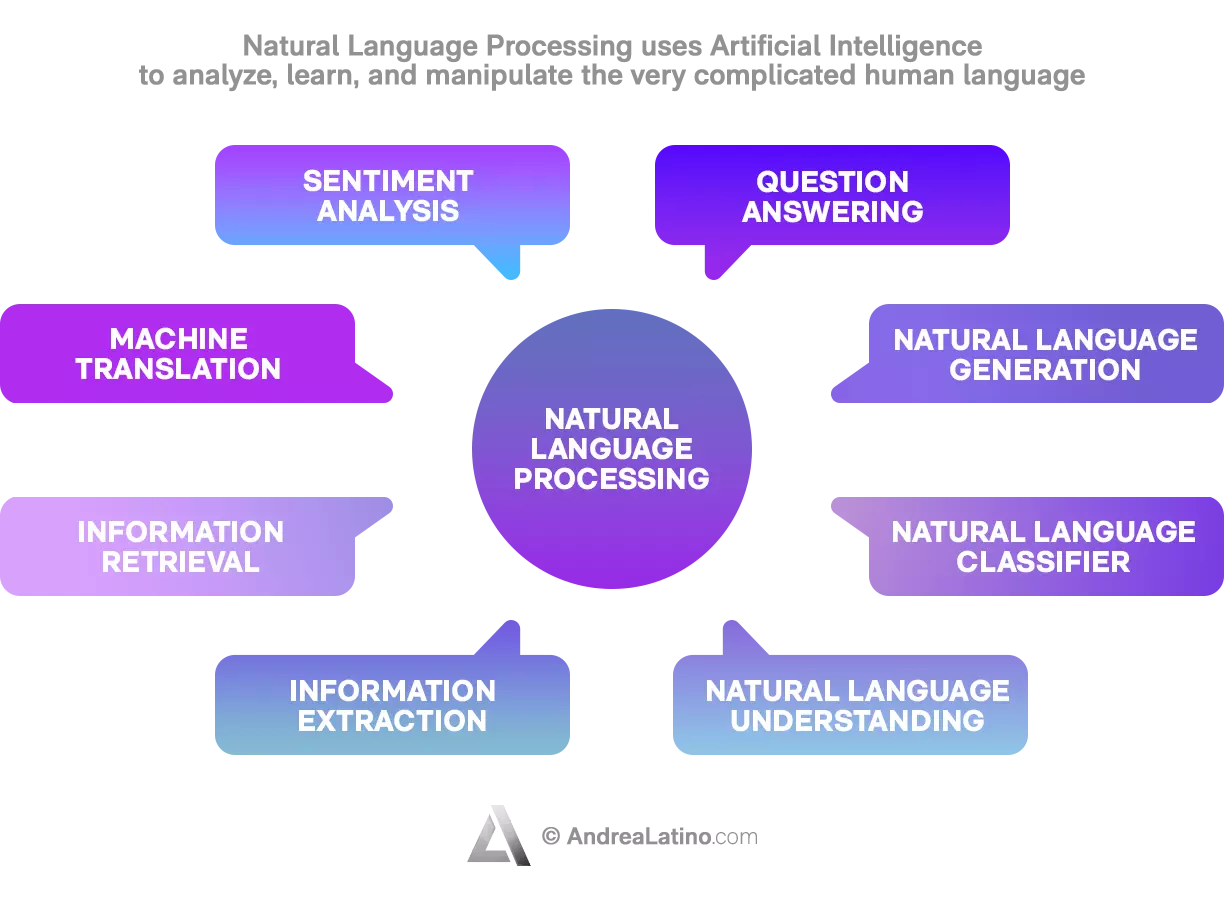Innovation Alphabet
Natural Language Processing (NLP)
In a nutshell
Natural Language Processing (NLP) is a computer application that uses Artificial Intelligence to analyze, learn, and manipulate the very complex human language. The purposes are many: to understand the content of a text, to translate it, or to make one autonomously from the input provided. In short, the software that all students have dreamed of while writing an essay.


Application Fields
• Intelligent conversational systems: With the help of deep learning, NLP technologies are able to emulate human dialogue by consistently answering questions on different topics.
• Sentiment analysis: Natural Language Processing can be used to analyze the level of satisfaction of users. It is a useful technique in the marketing and communication fields to understand which aspects of the company customers find satisfactory and which they would like to see improved.
• Text summary: The software can summarize texts, recognizing the most relevant information. It can do this by following two techniques: “extraction” involves identifying key phrases and using them as the basis of the summary, without adding extra content; “abstraction”, on the other hand, allows new phrases to be created by paraphrasing the entire original source.
Do you have a Strategy & Innovation challenge to tackle? Let’s face it. Together.
C-levels from these companies (AND MORE) relied on my expertise to overcome thEIR CHALLENGES IN THIS AREA. And You can, too.
Can I help you?Industries
• Natural Language Processing in the automotive industry
To analyze the data generated on Facebook, optimize its social presence, define its editorial plan, and support the marketing department, Piaggio has implemented Natural Language Processing techniques that combine methods of data mining (extraction of a large amount of data) and machine learning with information retrieval and, of course, NLP.
• Natural Language Processing in the language field
Grammarly is a writing tool that relies on the use of Natural Language Processing to correct grammatical and spelling errors. Grammarly focuses mainly on a close application of Artificial Intelligence for grammar assistance, but it can also check text clarity and suggest suitable synonyms.

Business Functions
• NLP in support of customer care
Apple devices can rely on the insights of Siri, the first true virtual assistant for smartphones. Siri uses two main technologies: speech recognition and Natural Language Processing. Basically, the computer process involves recognizing words spoken by a person and converting them into text form. By starting a sentence with the formula “Hey, Siri”, Apple’s speech recognition software kicks in and initiates digital transcription of the words.
• NLP in support of HR
Querying the candidate database by searching for keywords, skills or professional experience in advanced search fields, the algorithm that makes up the Performa Recruit software analyzes the information accumulated from reading resumes and sifts through it in search of the most suitable candidates for the position.
• NLP in support of customer service
Amtrak is the trade name for the U.S. suburban rail transportation system. The corporation found itself having to handle millions of inquiries from customers. By failing to answer each one’s questions, it was losing too many potential travelers. So, it turned to chatbots: software designed to simulate and process human conversations that were able to successfully handle more than 5 million messages.
Stay in wonderland
Let me show you how deep the rabbit hole goes.
Check out more of the Innovation Alphabet:

3D Printing
3D Printing
“3D printing” is a process carried out by an electronic device which, instead of resorting to the canonical ink, it molds almost any kind of material: from concrete to living tissue, most usually plastic, but also metal. And the operating principle is similar to that of a traditional printer. The creation of three-dimensional models can lead to the redesign of a company’s production capabilities.
Dive In
5G
5G
5G is the new frontier of cellular telephony. It was designed to improve (or completely replace) previous generations of mobile networks. The 5th generation features lower latency, ensuring flawless performance of business applications and many other digital experiences – thus enabling the new cultural generations to furiously play Fortnite away from home.
Dive In
Advanced Analytics
Advanced Analytics
The term “Advanced Analytics” refers to the ability to autonomously or semi-autonomously analyze data and content to identify correlations, develop analyses, predictions, and recommendations. It is not just a matter of collecting information and then organizing it into watertight compartments: the ultimate goal is to identify a dialogue pattern from a data-driven perspective.
Dive In
Agile
Agile
Agile is an approach to software development designed to respond to change. Teams quickly analyze the context in which they operate, identify uncertainties faced, and figure out how to adapt to always move forward. Interaction between individuals comes before processes and tools; collaboration with the customer is more important than negotiating contracts.
Dive In
Ansoff Matrix
Ansoff Matrix
The Ansoff Matrix is a marketing planning model that arises from the intersection of new and existing products and markets. It derives four possible strategies for expanding the company’s market, which are built around four variables with a changeable factor of risks and possibilities: existing product, new product, existing market, new market.
Dive In
Artificial Intelligence
Artificial Intelligence
Artificial Intelligence is not strictly defined. Basically, it is a computer system able to make decisions in an independent and flexible way. A good AI application can perform everyday tasks better than an average person (e.g., identifying other people from their photos on social media or beating the best chess player). Nothing to fear, then. Unless you are a chess champion.
Dive In
Artificial Scarcity
Artificial Scarcity
We often tend to desire what we cannot have. Or what we are in danger of losing: Artificial Scarcity is a strategy that flaunts a limited number of items that do not correspond to actual availability. The goal is to stimulate the perception in consumers that the stock of items is about to run out and thus create a need based on the “fear of being cut off” or the intention to buy the item in order to resell it at a higher price.
Dive In
Attack Surface
Attack Surface
The term attack surface refers to the part of a system that may be subject to attack or breach by hackers. The smaller that surface is, the easier it will be to protect it. Indeed, the Internet is an ocean of deep, dark waters: those who navigate it must be aware that they are exposing themselves to a flood of digital risks. Yet, ironically, we do not need a big boat to shelter us.
Dive In
Augmented Reality
Augmented Reality
Augmented Reality is an ever-evolving technology that overlays multimedia information on top of our common sensory horizon to gain a deeper understanding of our surroundings. No, it doesn’t allow you to step out of the Matrix dream simulation, nor can it be accessed by swallowing a red pill. But neither is it the disturbing experience of the Playtest episode of Black Mirror.
Dive In
Balanced Scorecard
Balanced Scorecard
In business, as in life, you need balance. The Balanced Scorecard is a holistic tool for strategic management. It offers, in fact, the possibility of assessing corporate performance in its wholeness. An overview that embraces four perspectives: the business/financial side, customers and stakeholders, internal processes, and learning and growth.
Dive In